Rosaceae . . . . Rose family
Note that many plants in the Rosaceae reproduce by 'apomixis' where seeds are produced without fertilisation, thus maintaining lineage identity, leading to the generation of what may be regarded as microspecies. Some also rarely hybridise giving rise to inter-generic hybrids
Choose closest flower colour:
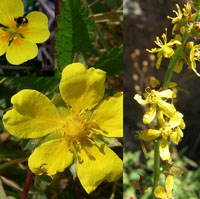
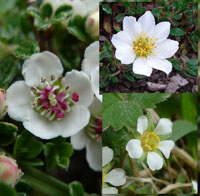
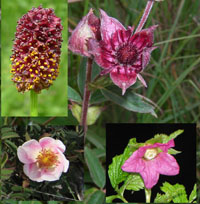
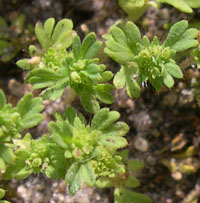
White-flowered Herbaceous plants:
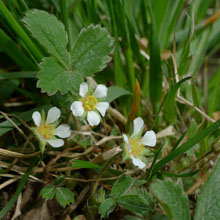
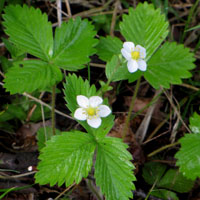

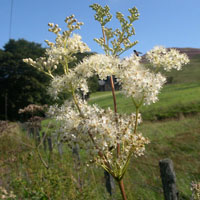

Rosaceae - pink or red flowers:
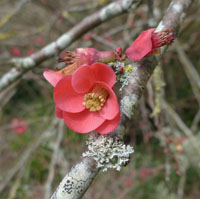
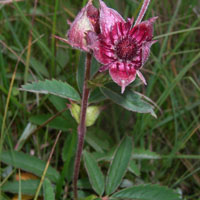
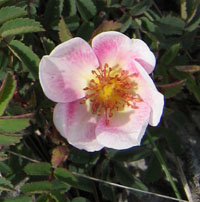
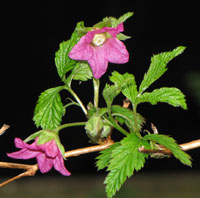
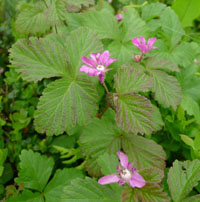
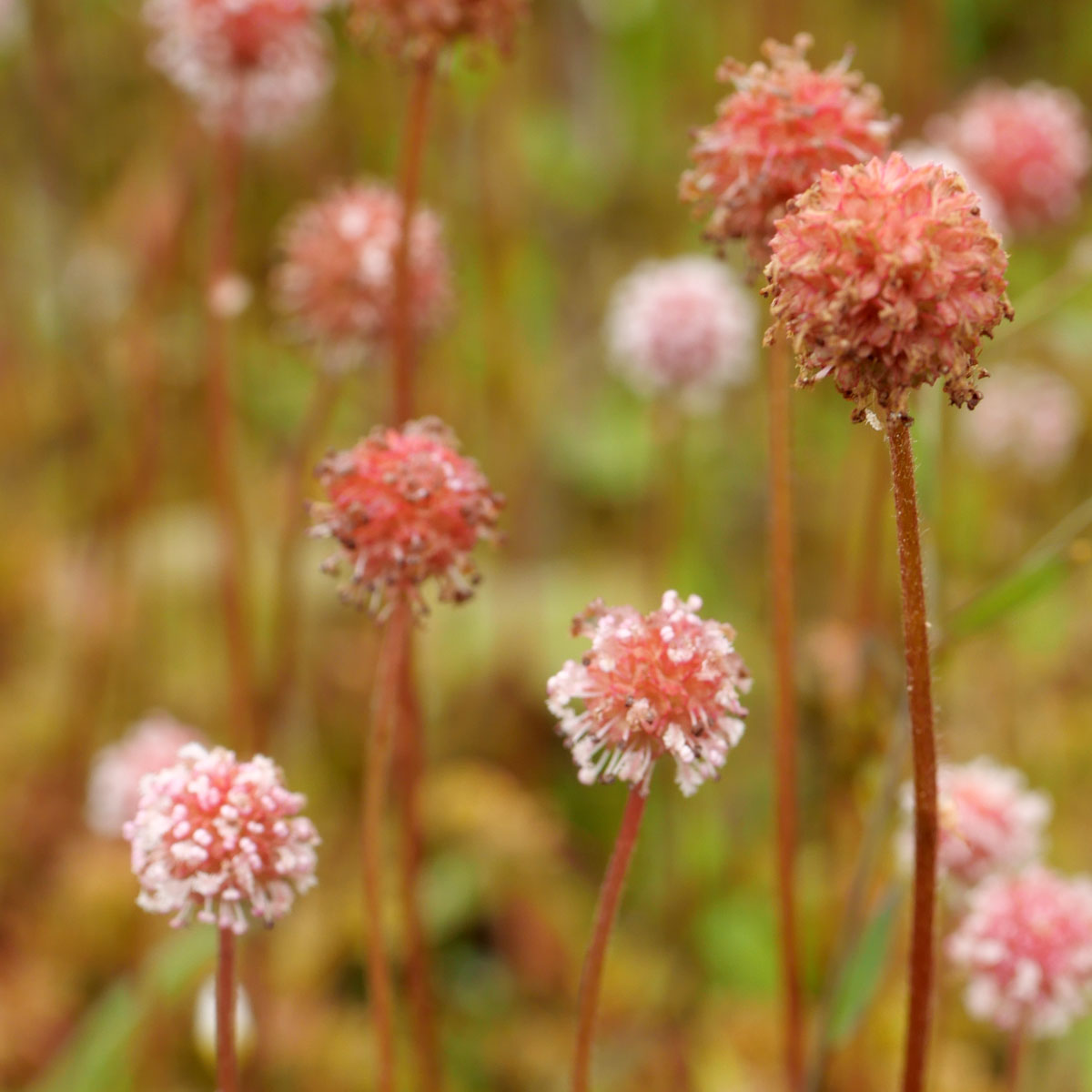
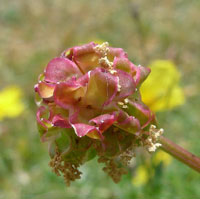
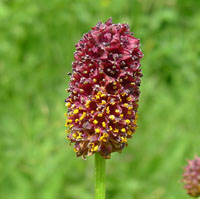
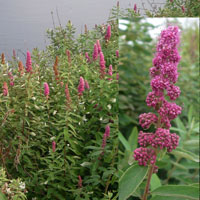
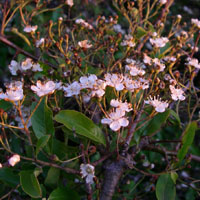
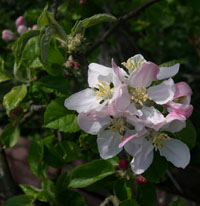
Rosaceae - yellow flowers
Agrimonies
Cinquefoils
Parsley pierts
Sibbaldia
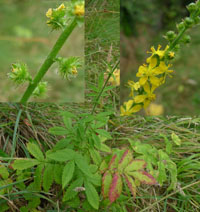
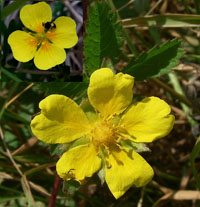

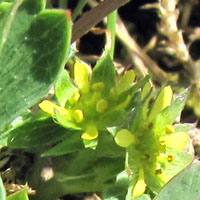
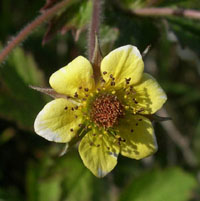
Rosaceae - green or non-descript flowers
Aphanes australis
Alchemilla alpina
Alchemilla glabra
Alchemilla glaucescens

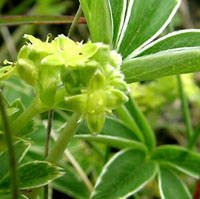
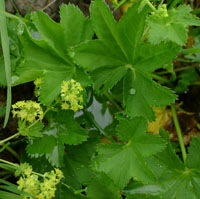
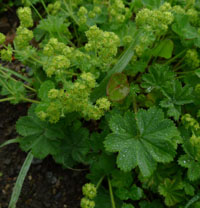
Cotoneaster cambrica
Acaena novae-zelandiae
Acaena anserinifolia
Poterium sanguisorba
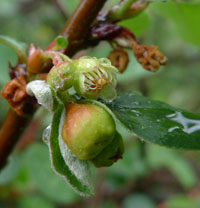


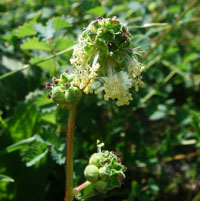
See also:
Swinecress 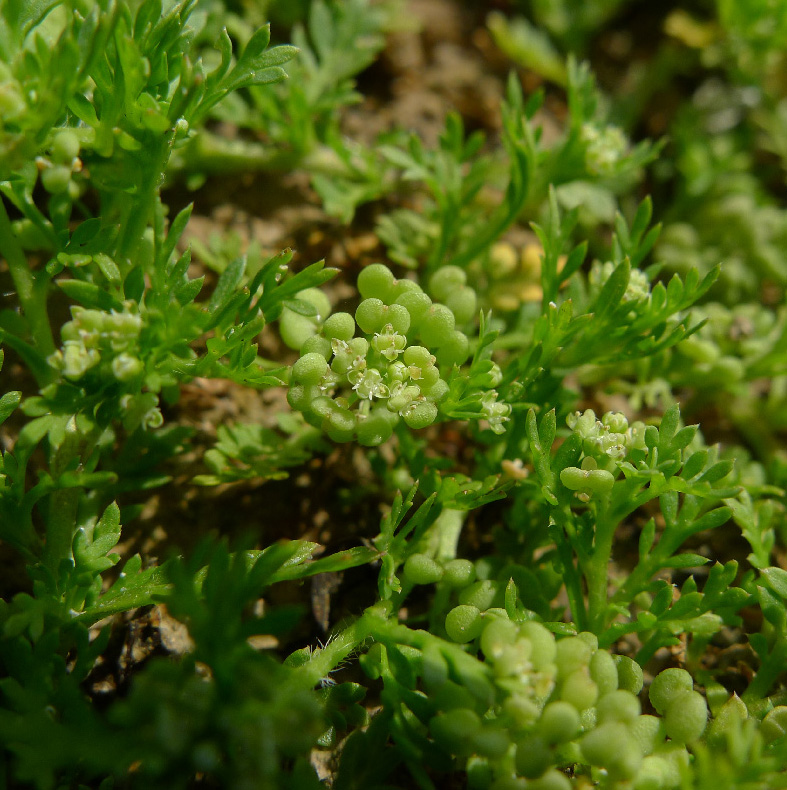 Poterium
Poterium 
Acaena . . . . . . Pirri-pirri bur
Acaena anserinifolia . . . . . . Bronze Pirri-pirri bur
Garden escape naturalised in a few places on bare ground

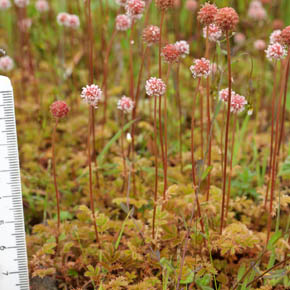
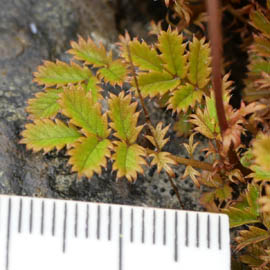
Acaena novae-zelandiae . . . . . . Pirri-pirri bur
Garden escape naturalised in a few places on bare ground

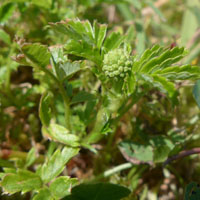
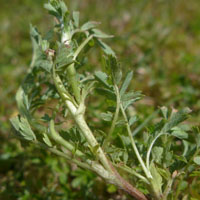
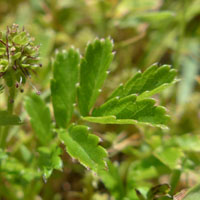
Agrimony
Agrimonies can be separated on the basis of the fruits as below:
- A. procera (L) has reflexed hooks with only shallow furrows
- A. eupatoria (R) has non-reflexed (patent) hooks and deep, full furrows in the fruit
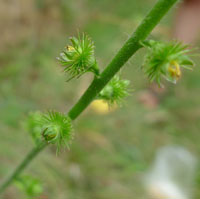
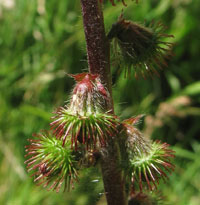
Agrimonia eupatoria . . . . Agrimony
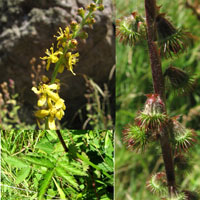

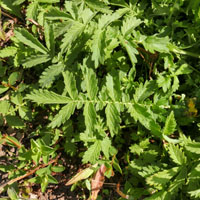
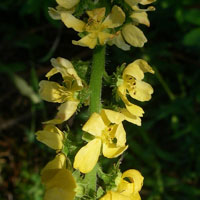
Agrimonia procera . . . . Fragrant agrimony
Sometimes fragrant when crushed



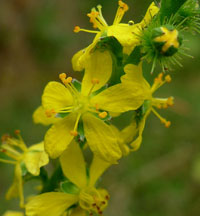
See also :
Golden rod 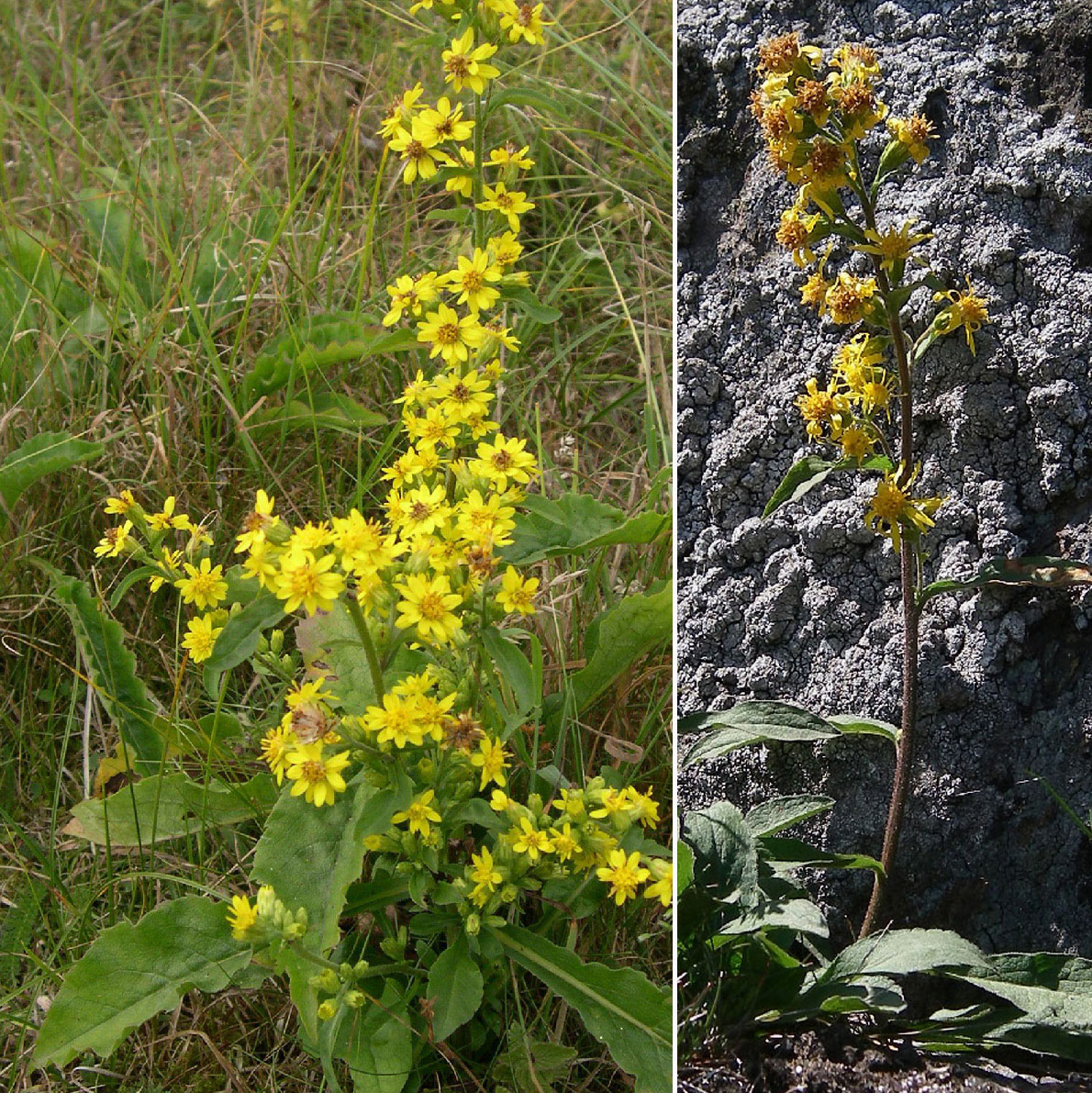
Alchemilla . . . . . . Lady's mantles
These are apomictic and have been separated into many microspecies; A. vulgaris agg. covers all the non-alpine (non-silky) spp.. N.B. The apparent 'petals' are actually sepals, with the 'sepals' formed from an epicalyx
The common garden spp. A. mollis can be separated from other spp. by the two rows of 'petals/sepals' being equal length (right side in picture below)
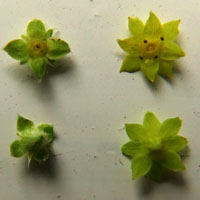
Alchemilla alpina . . . . . . Alpine Lady's mantle
Generally found at higher altitudes in mountains; a rather similar sp A. conjuncta (Silver lady's mantle) is grown in gardens

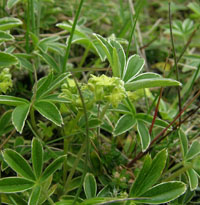
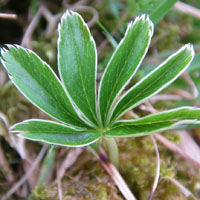
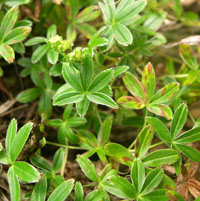
Alchemilla vulgaris agg. . . . . . . Lady's mantles
Some examples include:
Alchemilla glabra . . . . . . Smooth lady's mantle
Hairless leaves; common in N and W and mountain areas, rarer in S & E En and S Ire

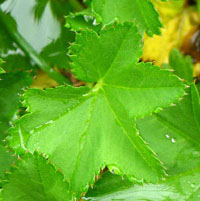
Alchemilla mollis . . . . . Garden lady's mantle
A robust plant with hairy leaves; note 'petals'/'sepals' equal length; widespread garden escape throughout BI
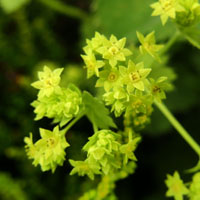
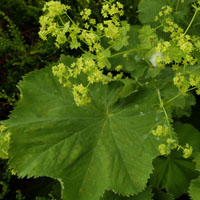
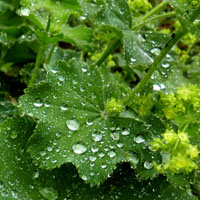
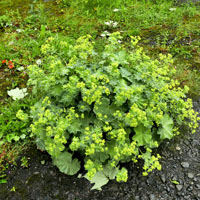
Some other spp. include:

Amelanchier . . . . June berry
Amelanchier lamarckii . . . . June berry
Increasingly cultivated and becoming naturalised in places
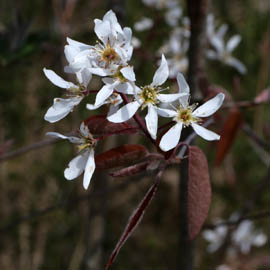
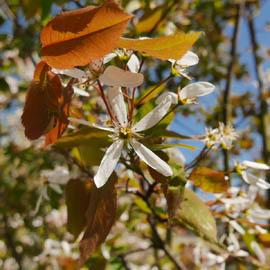
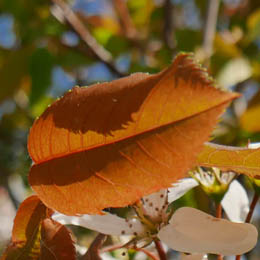
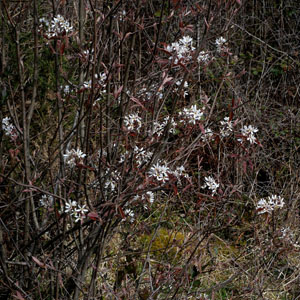
Aphanes . . . . . . Parsley Piert
Aphanes australis . . . . . . Slender Parsley Piert
Widespread on more acid soils, leaf tapers to petiole

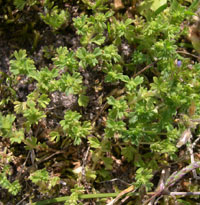
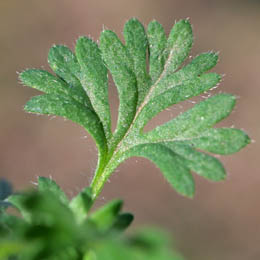
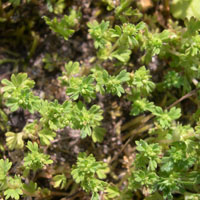
Aphanes arvensis . . . . . . Parsley Piert
Widely distributed esp. on base-rich soils; similar to the above, but with sepals reaching +/- to the end of the stipules (shorter in A. australis), lf base truncate
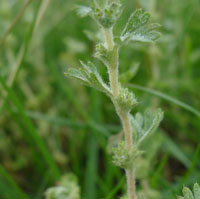
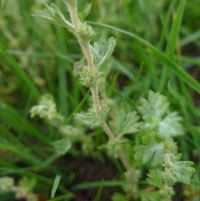
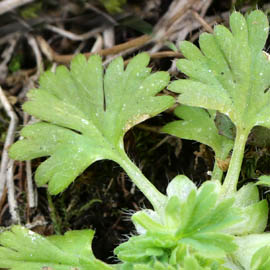
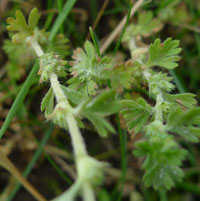
Aronia . . . . Chokeberry
Aronia melanocarpa . . . . Black chokeberry
Increasingly cultivated and becoming naturalised in places
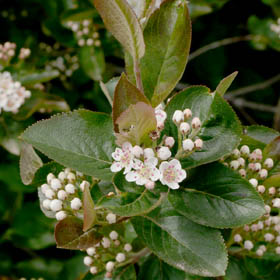
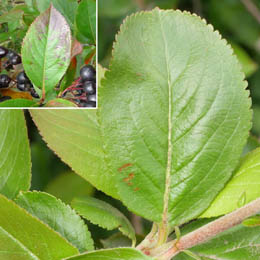
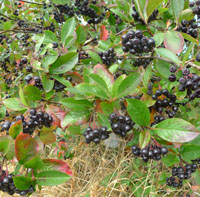
Aruncus . . . . Buck's-beard, or Goat's Beard
Aruncus dioica . . . . Buck's-beard
Widely grown in gardens and naturalised in scattered, mostly wet places across Br




Comarum . . . . . Marsh cinquefoil
Comarum palustris . . . . Marsh cinquefoil (was Potentilla)
Marshes and bogs, esp. in N

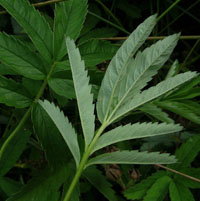
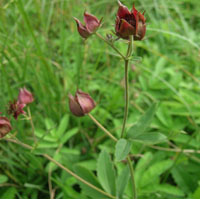
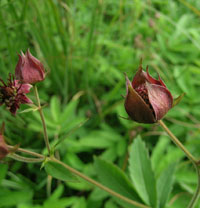
Chaenomeles . . . . . Japanese quince, Japonica
Chaenomeles x superba . . . . Japonica or Japanese quince
The common garden plant is often the hybrid between C. speciosa (Chinese quince) and C. japonica (Japonica), though both parents occur; all are difficult to distinguish. Naturalised in places

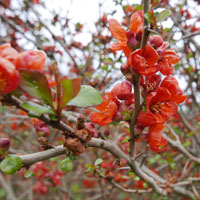
Cotoneaster . . . . . Cotoneasters
There are many "spp.", mostly apomictic, mostly escapes from cultivation (Stace gives 93 spp. and hybrids ; the commonest are the small-leaved (deciduous) Wall cotoneaster (C. horizontalis) which has small leaves on horizontally spreading stems, and Waterer's cotoneaster (C. x watereri). Some others are illustrated below, but tend to be difficult to separate
The only native sp. is the rare (only found in the wild on Gt Orme's Head) Wild cotoneaster (C. cambricus)
Cotoneaster sp
Cotoneaster x watereri
Cotoneaster frigidus
Cotoneaster bullatus
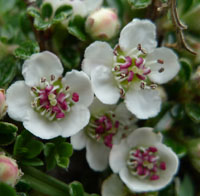
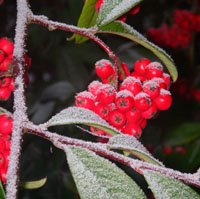
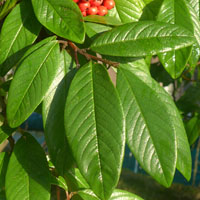
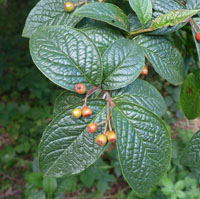
Cotoneaster sp.
Waterer's c.
Tree cotoneaster
Cotoneaster cambricus
Cotoneaster cambricus
Cotoneaster simonsii
Cotoneaster sp. (evergreen)

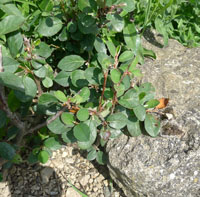
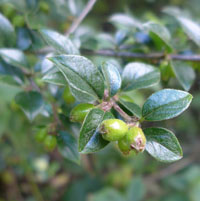
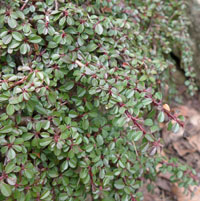
Great Orme cotoneaster
Great Orme cotoneaster
Cotoneaster simonsii
Cotoneaster sp. (evergreen)
Cotoneaster horizontalis (deciduous)
Cotoneaster horizontalis (deciduous)
Cotoneaster vilmorinianus
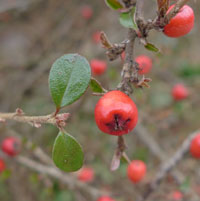
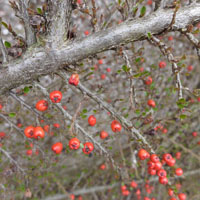
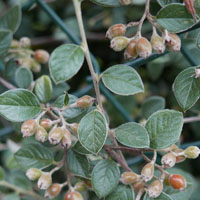
Crataegus . . . . . Hawthorn
>11 spp. recognised by Stace; here treated as one sp., though note that most plants with red/pink fls would be C. laevigata (Midland hawthorn - see below), the main other native sp.
Crataegus monogyna . . . . Hawthorn or May
Common in hedgerows
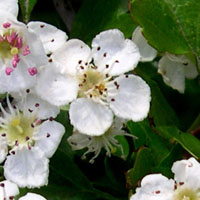
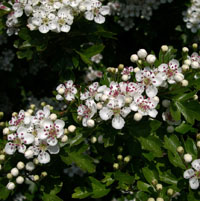
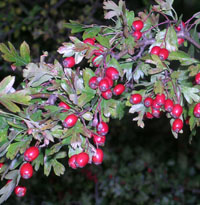
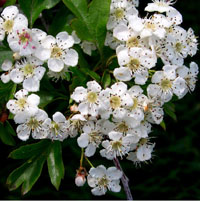
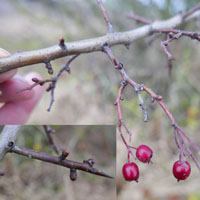
Crataegus laevigata . . . . Midland Hawthorn or May
In hedgerows esp. from C to SE En; shown on R cf. C. monogyna on L
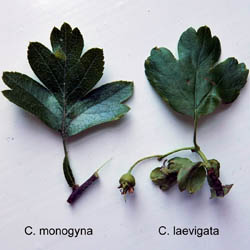
Dasiphora . . . . . Shrubby cinquefoil
Dasiphora fruticosa (=Potentilla fruticosa). . . . . . Shrubby cinquefoil
Rare in the wild except in W Ire and Teesdale (though an Asiatic variety is widely grown and commonly escapes)
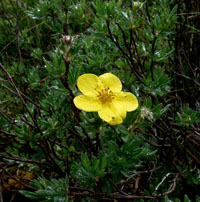
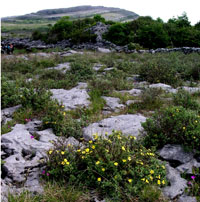
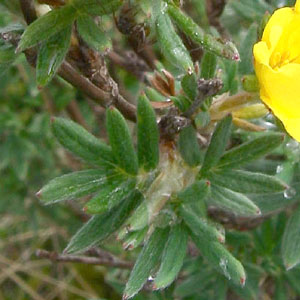
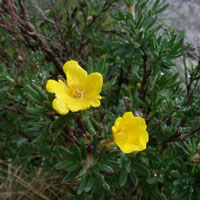
Dryas . . . . . Mountain avens
Dryas octopetala . . . . Mountain avens
An arctic sp. reaching S limit in UK; very local (mostly in Sc) on base-rich mountain ledges, but down to sea level in the very far N
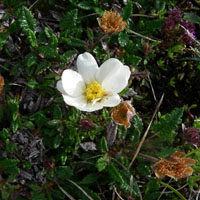
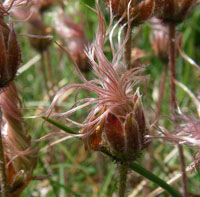
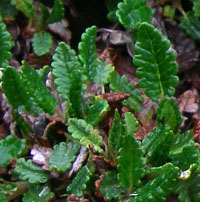
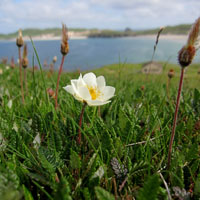
Filipendula . . . . . .Meadowsweet and Dropwort
Filipendula vulgaris . . . . Dropwort
Calcareous grassland mostly in the S and C Br and W Ire; 8-20 leaflet pairs
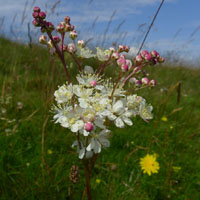
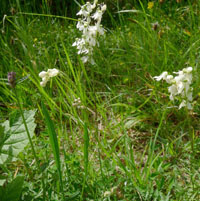
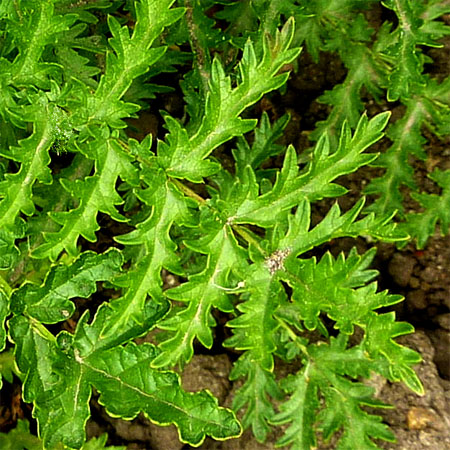
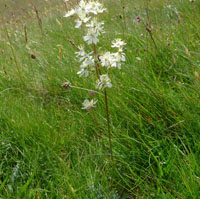
Filipendula ulmaria . . . . Meadowsweet
Damp places throughout BI; honey-scented
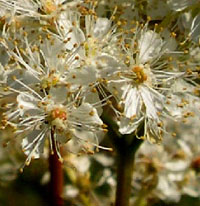
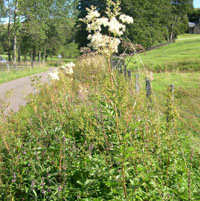
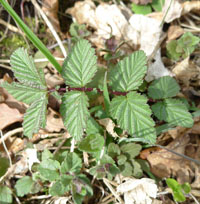

Fragaria . . . . . . Wild strawberry
Fragaria vesca . . . . . . Wild strawberry
Common in woods and scrub
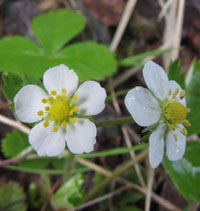
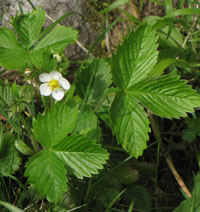
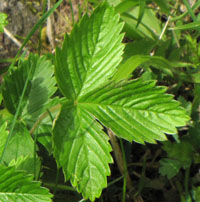
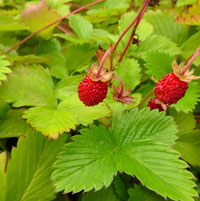
The garden strawberry (F. ananassa) is larger in all parts than the wild strawberry and has many stolons
See also: Potentilla sterilis

Note that terminal tooth of leaflets longer than neighbours in F. vesca, but not in P. sterilis, also note gap between petals in P. sterilis
Geum . . . . . Avens
Geum urbanum
Geum macrophyllum
Geum rivale
Geum rivale x urbanum = intermedium

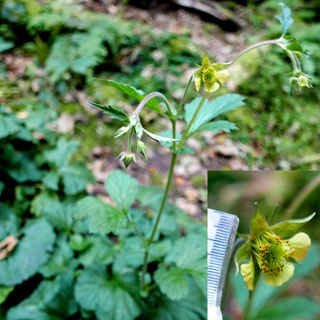
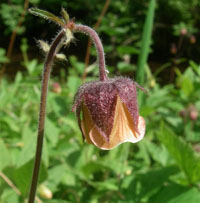
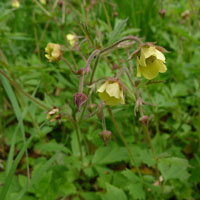
Wood avens
Hybrid avens
Water avens
Water avens variant
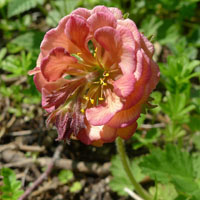
Geum rivale . . . . . . Water avens
Throughout BI exc. SE, common in N

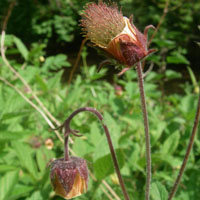
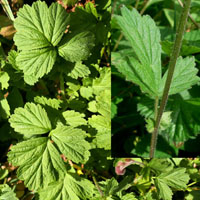
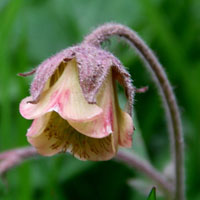
Odd mutant of G. rivale

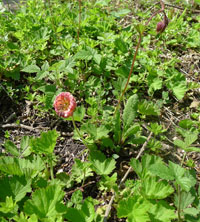
Geum urbanum . . . . . . Wood avens
Common in woodland exc. N tip of Sc
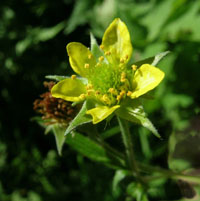
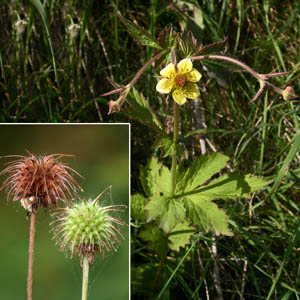
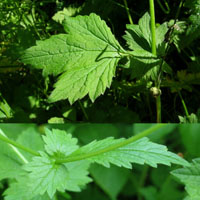

Note that G. urbanum leaves (on R below) are similar to Goldilocks buttercup (on L below)
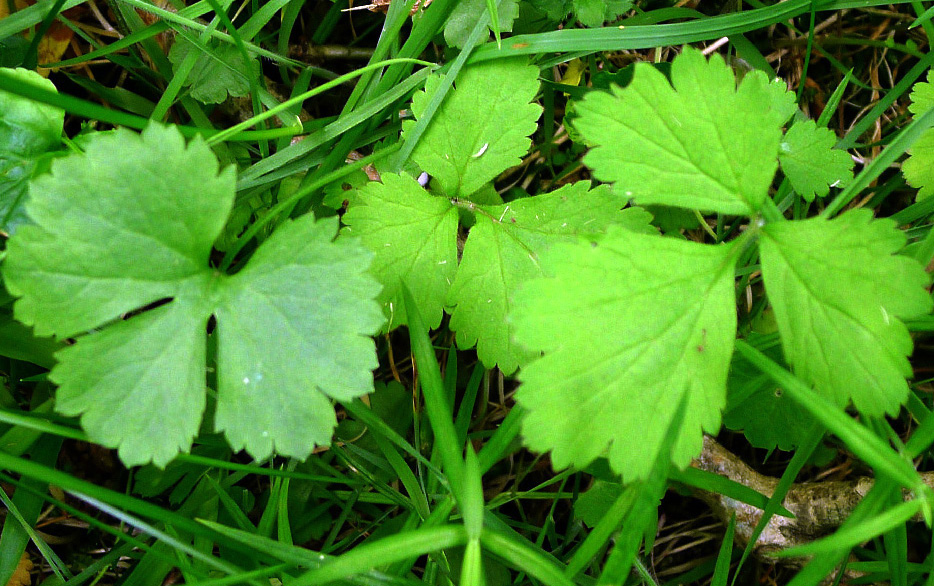
Geum macrophyllum . . . . Large leaved Avens
Scattered in woodland; distinguished by large, apparently roundish (actually pinnate) lvs; 3rd pic compares with smaller G. urbanum

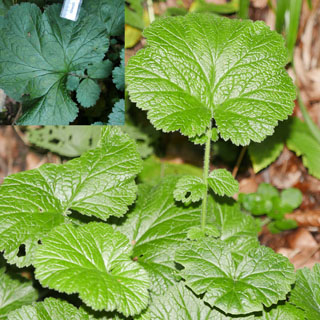
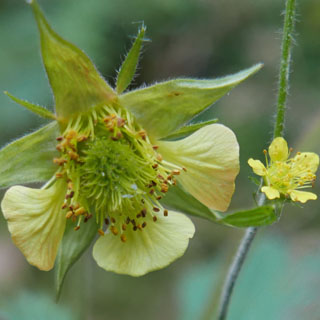
Geum rivale x urbanum = intermedium . . . . . . Wood x water avens
A reasonably common hybrid, esp. in WA, N En and Sc

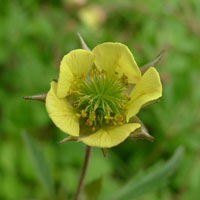
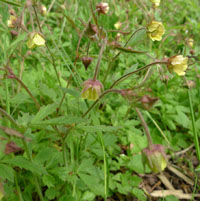
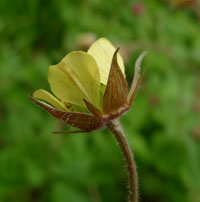
Malus . . . . . .Apple
Malus domestica . . . . . . Apple

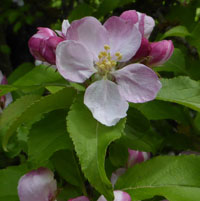
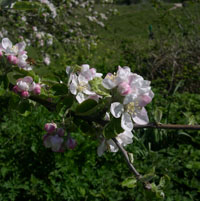
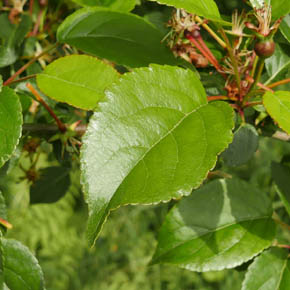
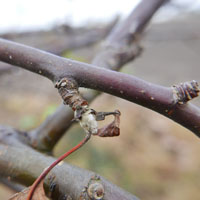
Mespilus . . . . . Medlar
Mespilus germanica . . . . . . Medlar
Local in CI and S
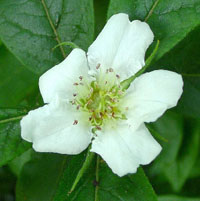
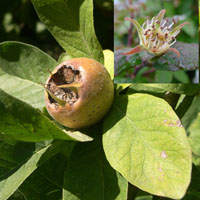
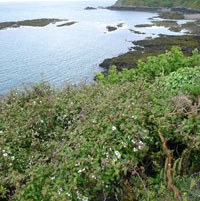
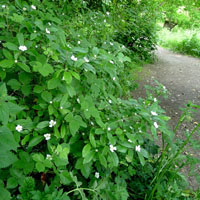
Photinia . . . . . Stranvaesia
Photinia davidiana . . . . . . Stranvaesia
Local in CI and S
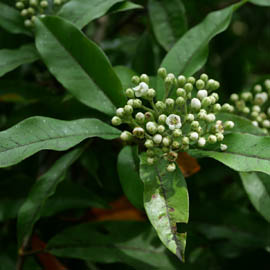
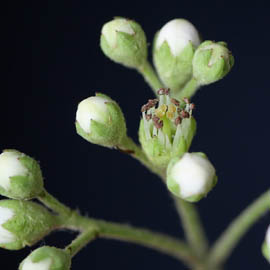
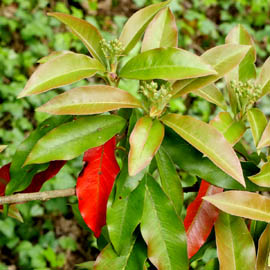
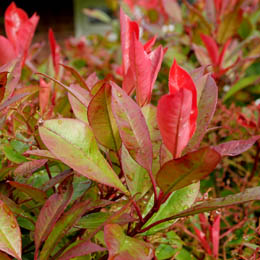
Physocarpus . . . . Ninebark
Physocarpus opulifolia . . . . Ninebark
A scattered relic of cultivation
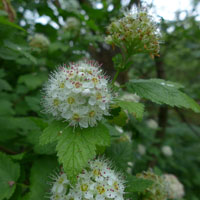
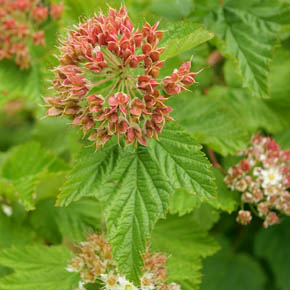
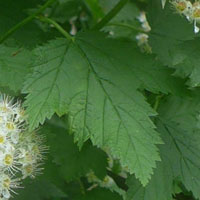
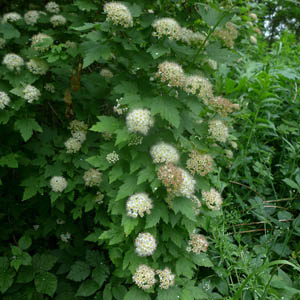
Can be confused with Viburnum
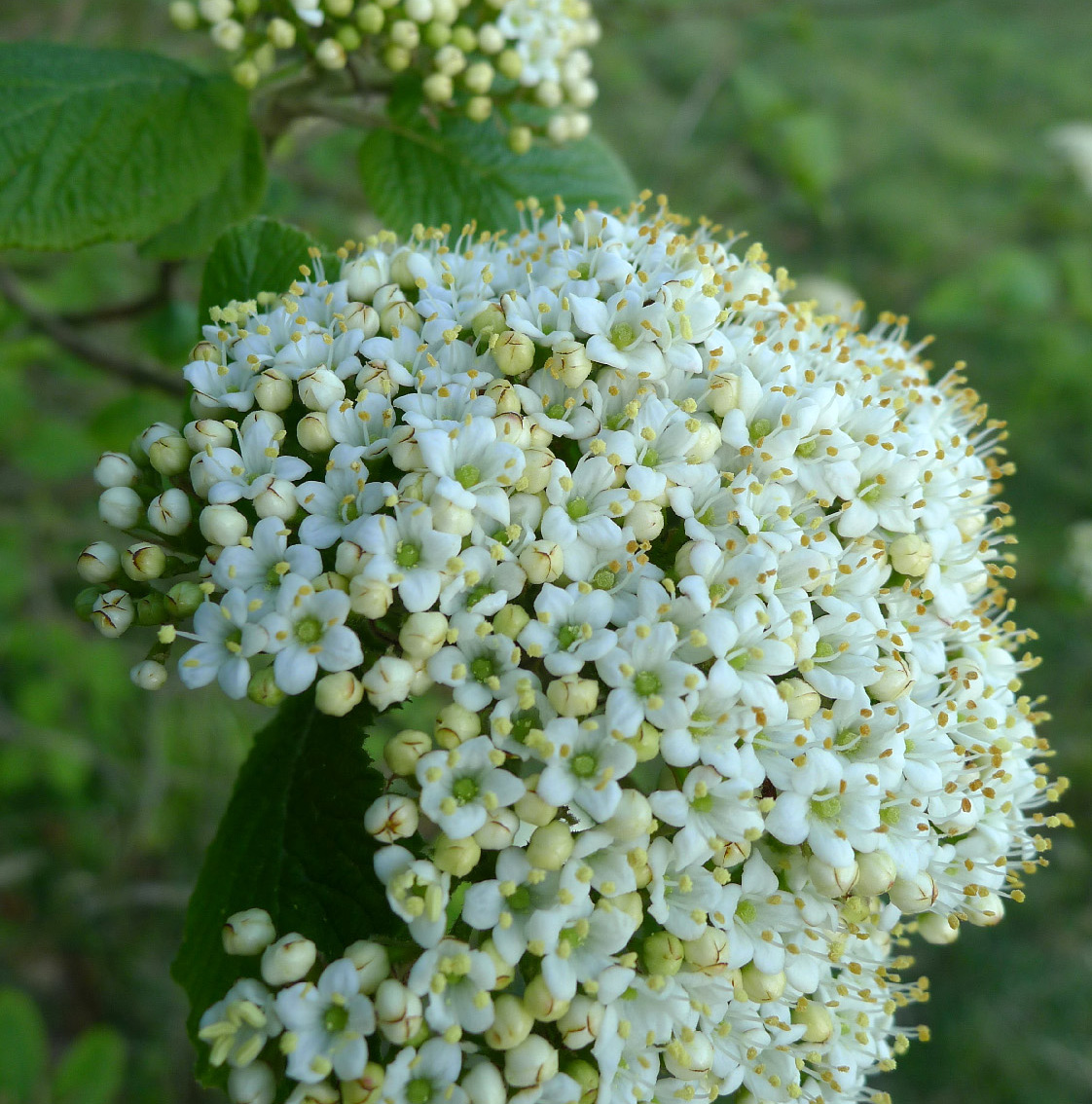
Potentilla . . . . . . Cinquefoils
Select from:
See also:
Several other spp. occur as casuals including:
P.recta (Sulphur cinquefoil),
P. inclinata (Grey cinquefoil),
P. intermedia (Russian cinquefoil),
P. montana (W cinquefoil), as well as rare spp.
Potentilla anglica . . . . . . Trailing tormentil
Scattered throughout BI; leaf stalks <2cm, eventually rooting at nodes
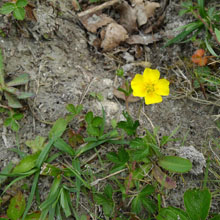
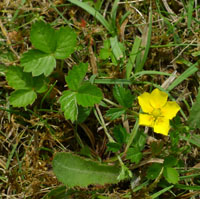
Potentilla anserina . . . . . . Silverweed
Pastures and waysides, but particularly common by the sea; pinnate lvs with silver underside
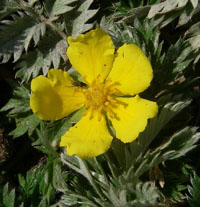
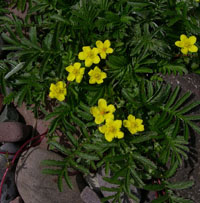
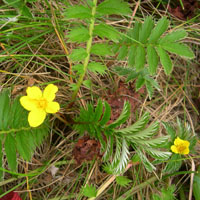
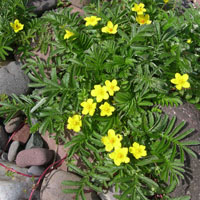
Potentilla argentea . . . . . . Hoary cinquefoil
Local and decreasing in CI to C Sc
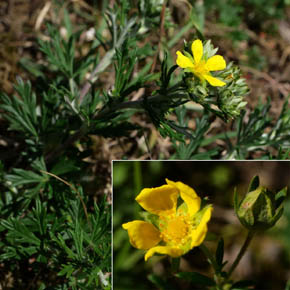
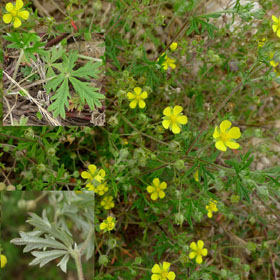
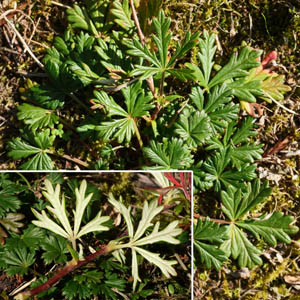
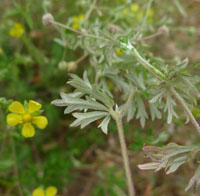
Potentilla crantzii . . . . . . Alpine cinquefoil
Very local on basic rocks/grassland on mountains, mostly in Sc highlands
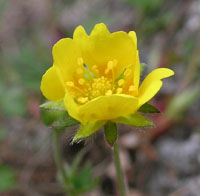
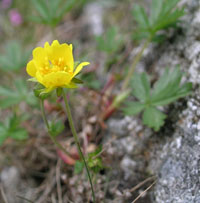
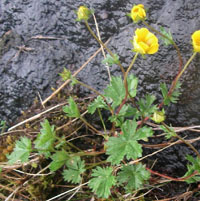

Potentilla erecta . . . . . . Tormentil
Common and widespread on heaths and mountains esp. on acid soils; unstalked lvs
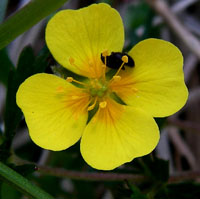
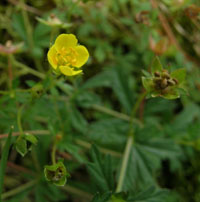
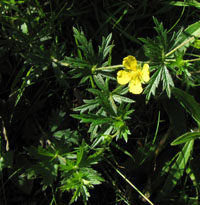
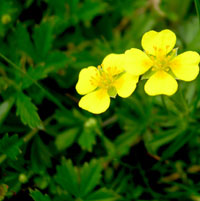
Other plants with mostly 4-petalled fls include P. anglica (>20 carpels, and lower lvs with stalks >1cm) P. x Mixta (with sterile fls).
Potentilla indica . . . . . . Yellow-flowered strawberry
Scattered in CI, C & S Br and elsewhere
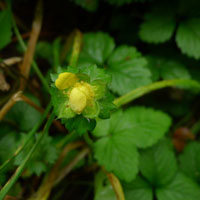
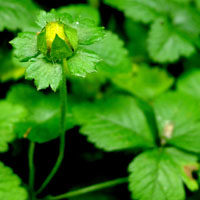
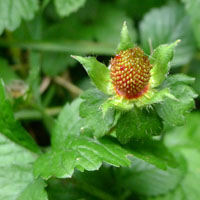
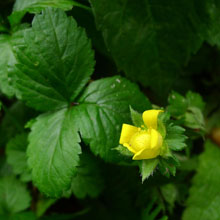
Potentilla norvegica . . . . . . Rough or Ternate-leaved Cinquefoil
A scattered casual, N to C Sc; characterised by upright habit and three leaflets
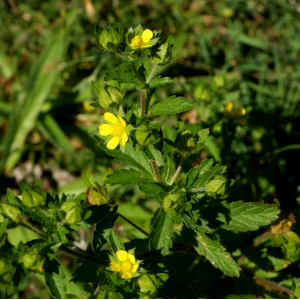
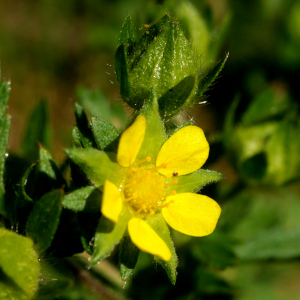
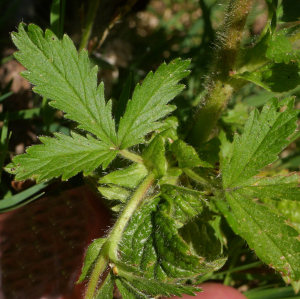
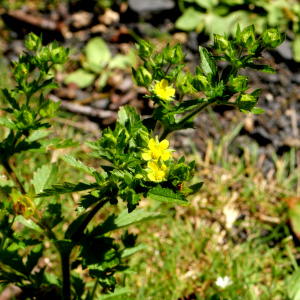
Potentilla reptans . . . . . . Creeping cinquefoil
Common in Br N to C Sc, local further N; long-stalked lvs, clearly rooting at nodes
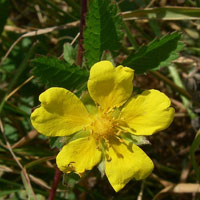
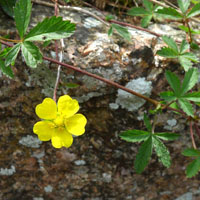
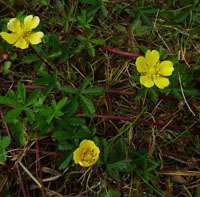
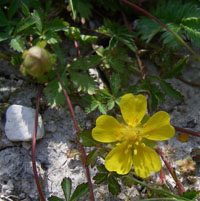
Potentilla rupestris . . . . . . Rock cinquefoil
V rare in the wild with recent records mostly confined to Radnorshire and E Sutherland
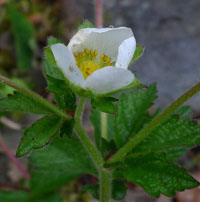
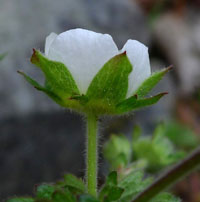

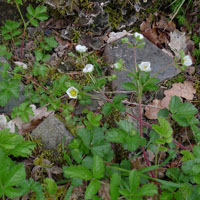
Potentilla sterilis . . . . . . Barren strawberry
Note the wide gap between petals in this sp.; also top tooth of terminal leaflet is shorter than neighbours
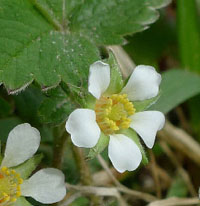

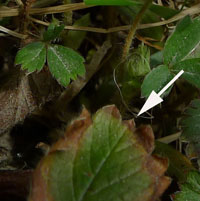
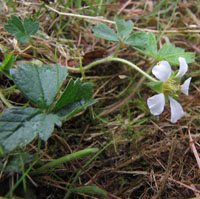
Compare: Fragaria vesca which has closer petals and long terminal leaflet

Potentilla verna . . . . . . Spring cinquefoil
Local on dry basic grassland (was P. neumanniana or P. tabernaemontani)
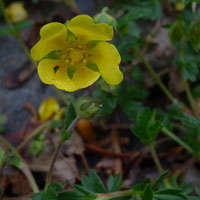
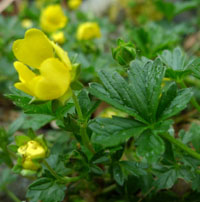
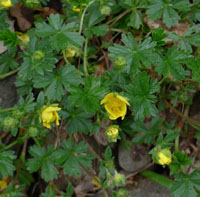
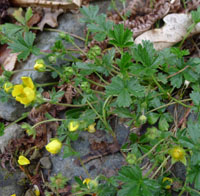
Poterium . . . . . Salad burnet
Poterium sanguisorba . . . . . Salad burnet
Esp. on chalk and limestone

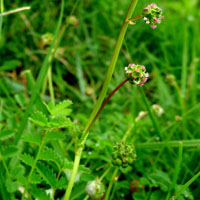
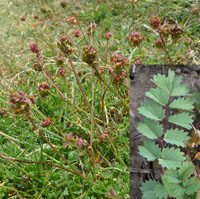

See also Sanguisorba . . . . . Greater burnet

Prunus . . . . . Cherries and plums
Choose from:
Flowers,
Fruit, or
Leaves
Flowers:
Prunus spinosa
Prunus cerasifera
Prunus avium
Prunus domestica
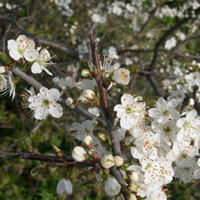
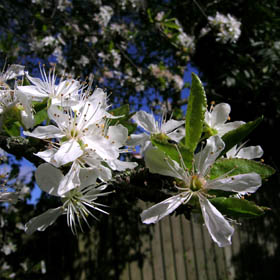
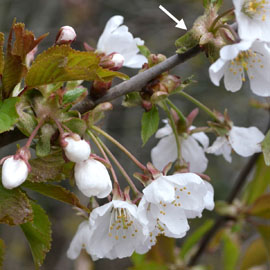
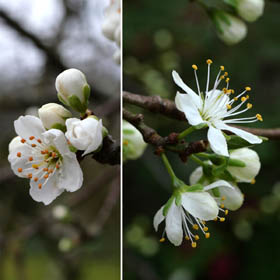
Blackthorn
Myrobalan
Wild cherry
Plum
Prunus padus
Prunus lusitanica
Prunus laurocerasus
Laurus nobilis (Lauraceae)
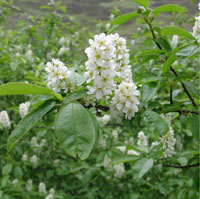
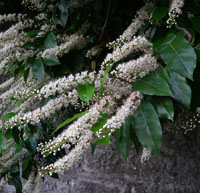

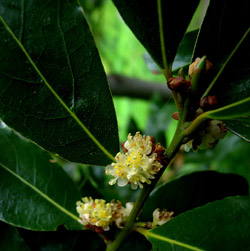
Bird cherry
Portuguese laurel
Laurel
Bay
In addition there are many cultivated cherry spp. (
Prunus serratula with sharp teeth on lvs) and cv. e.g.:
P. x subhirtella
P. 'Kanzan'
P. 'Shirofugen'
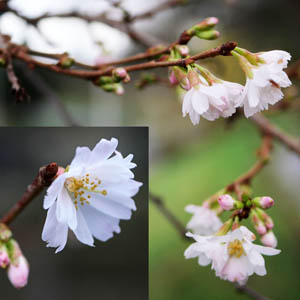
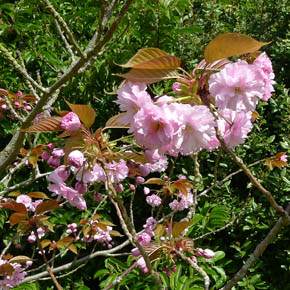
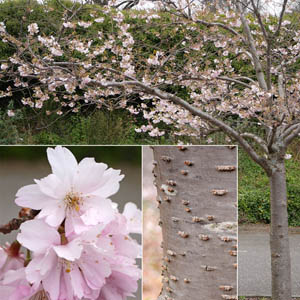
Winter fl. cherry
'Kanzan' Cherry
'Shirofugen' Cherry
Prunus avium . . . . . . Wild cherry
Has been widely planted but also seeds naturally; note constriction below petals and fine teeth on retained bud scales

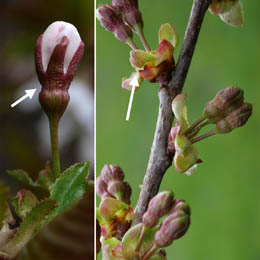
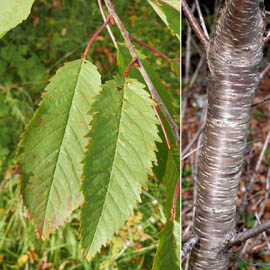

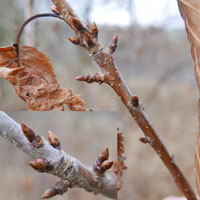
Prunus cerasifera . . . . . . Myrobalan cherry-plum
Early flowering (early Mar.) very variable including yellow-fruited (Mirabelle) and red-fruited cvs.; new shoots green; sepals blunt, reflexed, with fine projections (pic1); petals c.10 mm
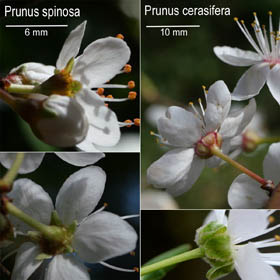

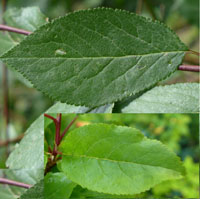
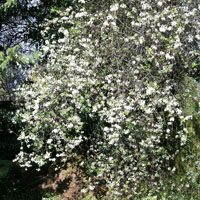
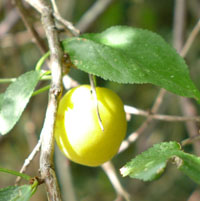
Prunus domestica subsp insititia . . . . . . Damson or wild plum
Widespread in hedgerows

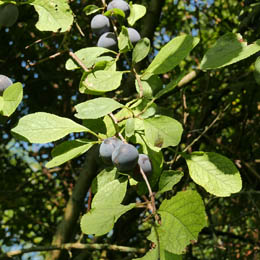
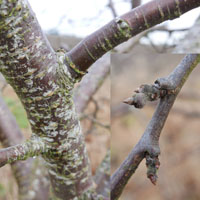
Prunus laurocerasus . . . . . . Cherry laurel
Widely planted, commonly naturalised in woodland

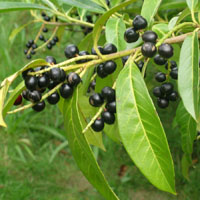
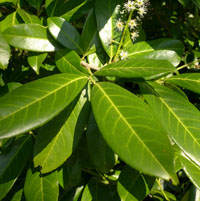
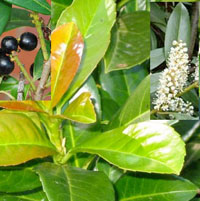
Widely planted in landscaping is the dwarf form cv. 'Otto Luyken', uncommonly naturalised (esp. around London)
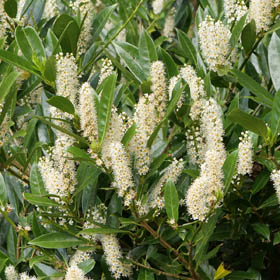
Prunus lusitanica . . . . . . Portugal (or Portuguese) laurel
Young shoots often deep red; less common than P. laurocerasus but scattered in shrubberies etc across BI (less so N Sc and W Ire)
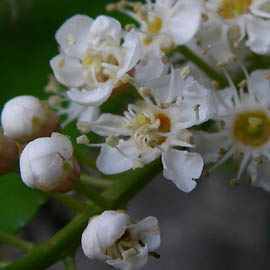

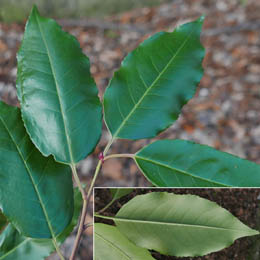
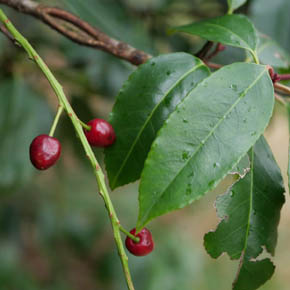
N.B. Compare also:
Prunus padus . . . . . . Bird cherry
Most common in the N; petals >6mm, fruit <8mm

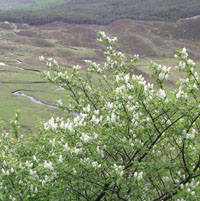

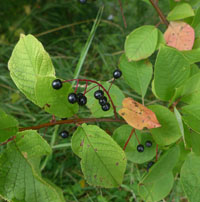
Similar is Rum cherry (Prunus serotina) with petals <5mm, fruit >8mm retaining sepals and invasively spreading esp. across C & S En
Prunus spinosa . . . . . . Blackthorn or Sloe
Common in hedges or scrub; flowers c.April (Blackthorn winter); sepals not reflexed, triangular; petals c.6 mm; new shoots brownish, hairy
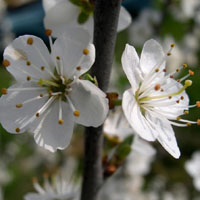

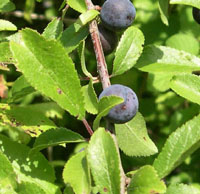

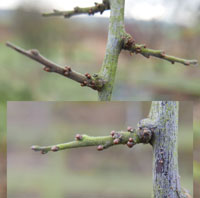
Prunus x subhirtella 'Autumnalis'. . . . . . Winter flowering cherry
Commonly planted across UK and Ire - flowers from Nov to Mar

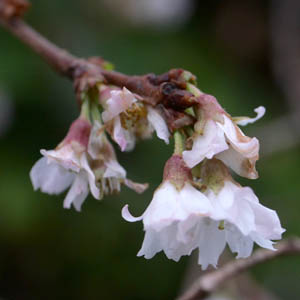
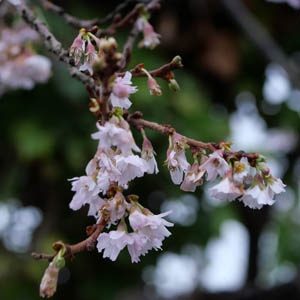
Pyracantha . . . . . . Firethorn
V. spiny garden escapes, with P. coccinea being the more common, distinguished by hairy fl stalks & petioles
P. rogersiana
P. coccinea
P. coccinea
P. coccinea

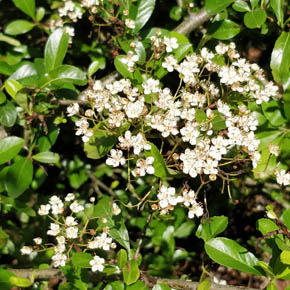
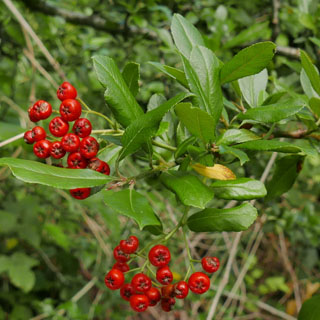
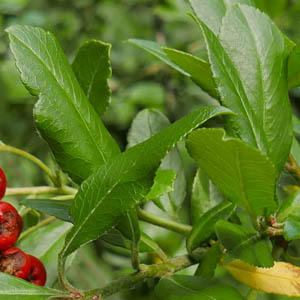
Pyrus . . . . . . Pear
Pyrus communis . . . . . . Pear
Garden origin; NB is non-spiny tree with inedible fruits >5cm (c.f. P. pyraster, the wild pear, which occurs mainly in CI and S to C Br)
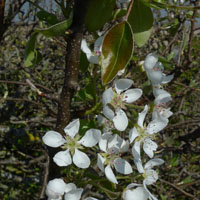
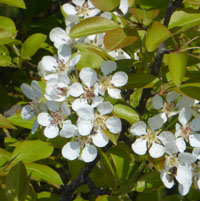
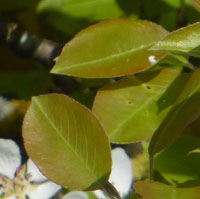
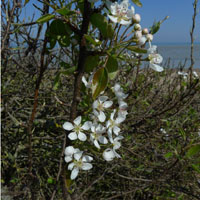
Pyrus calleryana . . . . . . Callery pear
'Chanticleer' is widely planted
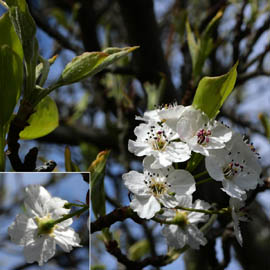
Pyrus pyraster . . . . . . Wild Pear
Fruits roundish, inedible, <4cm; occurs mainly in CI and S to C Br or as rootstock from cultivated plants; sometimes only distinguished from P. communis in fruit
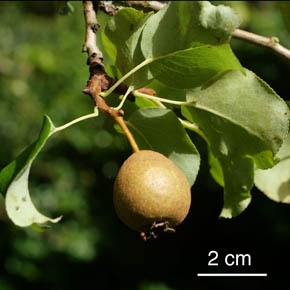
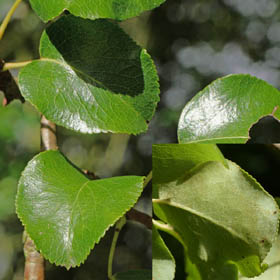
Rosa . . . . . . . . Roses
There are a large number of rose species or hybrids that may be found in the wild; some are shown below:
R. canina agg.
R. spinosissima
R. rugosa
R. luciae
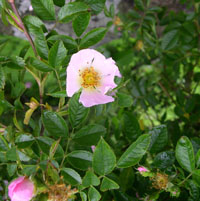
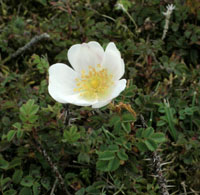
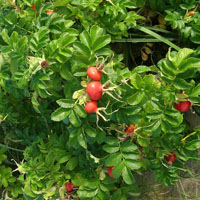
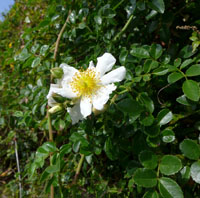
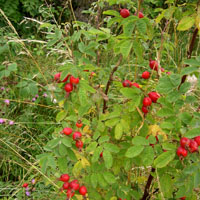
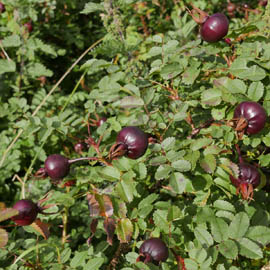
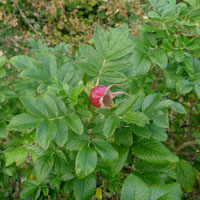
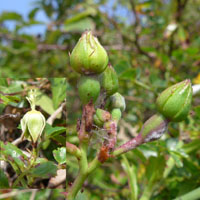
Dog rose
Burnet rose
Japanese rose
Memorial rose
R. micrantha
R. virginiana
R. multiflora
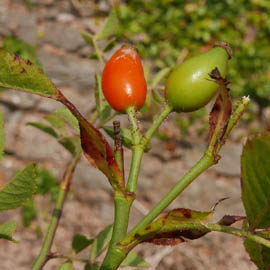
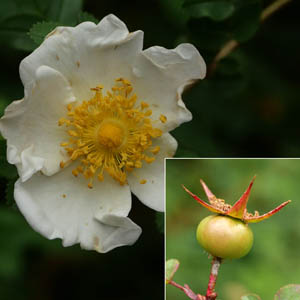
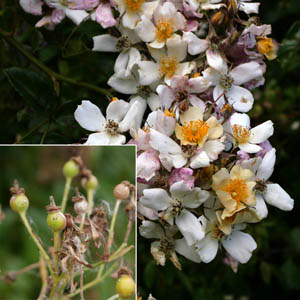
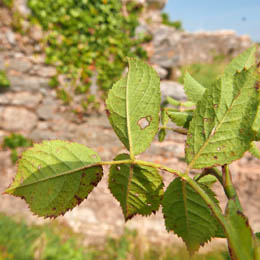
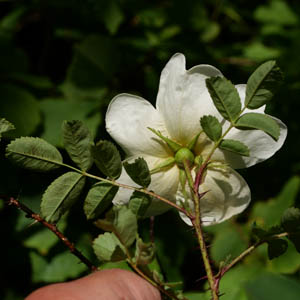

Small sweet-briar
Virginian rose
Many-fld rose
Rubus . . . . . Berries
Again these are apomictic generating large numbers of variants. A few of the main spp. are shown below - choose the nearest:
Rubus fruticosus
Rubus caesius
Rubus idaeus
Rubus spectabilis
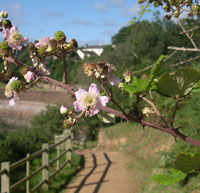
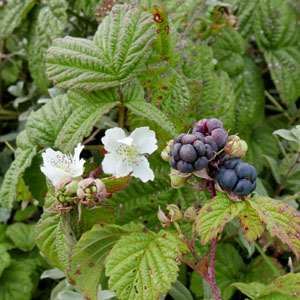
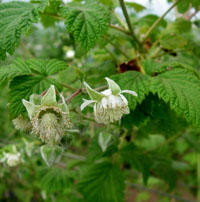

Blackberry
Dewberry
Raspberry
Salmonberry
Rubus chamaemorus
Rubus arcticus
Rubus saxatilis
Rubus laciniatus
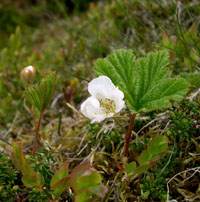

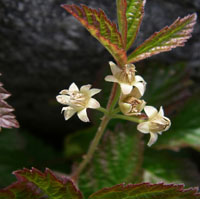
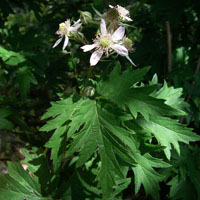
Cloudberry
Arctic bramble
Stone bramble
Cut-lvd Bramble
R. tricolor
R. cockburnianus
R. phoenicolasius
R. deliciosus
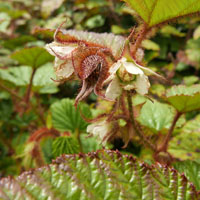
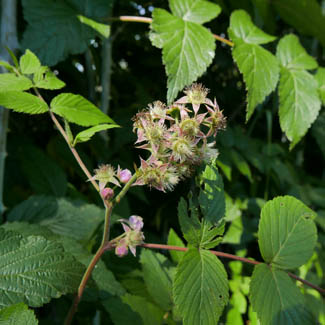
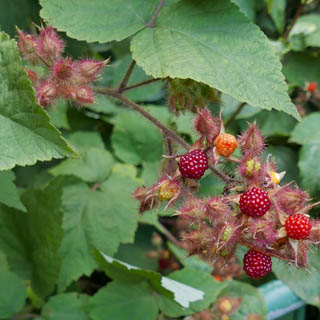
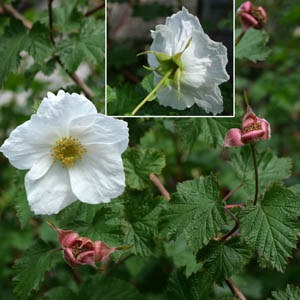
Creeping chinese bramble
White-stemmed bramble
Japanese wineberry
Rocky-mt raspberry
Rubus arcticus . . . . . . Arctic bramble
Extinct in the wild in Br

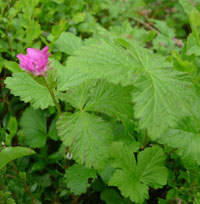
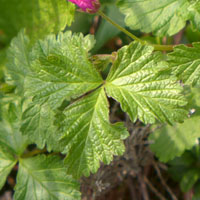
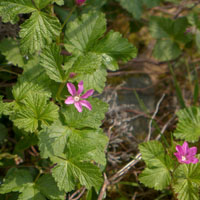
Rubus caesius . . . . . . Dew berry
Throughout BI, has few drupes to each berry; fruits earlier than most blackberries

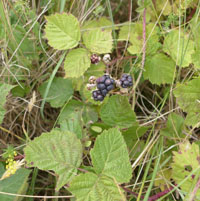
Rubus chamaemorus . . . . . . Cloud berry
Peaty moors and bogs on mountains
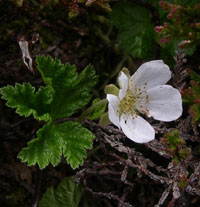


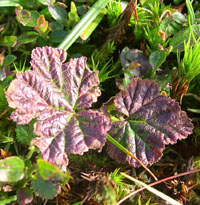
Rubus cockburnianus . . . . . . White-stemmed bramble
Garden escape across En and Sc
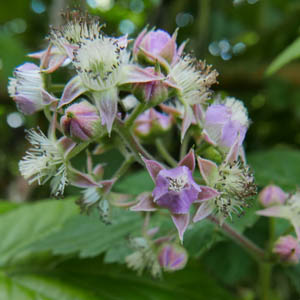

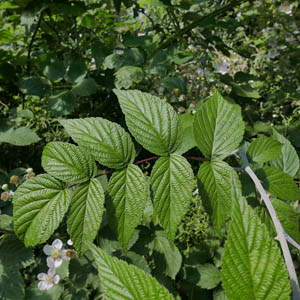
Rubus delicicosus . . . . . . Rocky-mountain Raspberry
Simple palmately-lobed lvs, large (c.5 cm) single fls and red berries; rarely planted/escaping
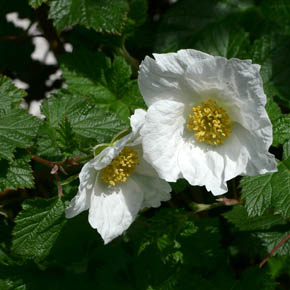

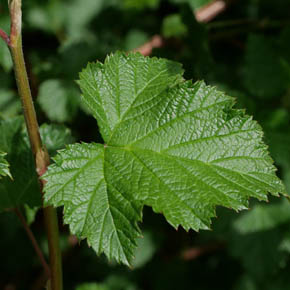
Rubus fruticosus agg. . . . . . . Blackberry or Bramble
Many variants have been recognised; widespread in hedgerows and scrub

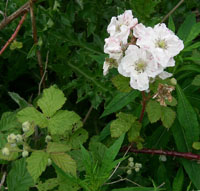
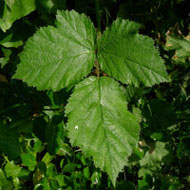
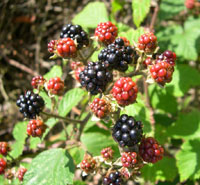
Rubus idaeus . . . . . . Raspberry
Widespread

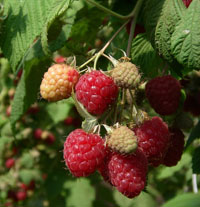
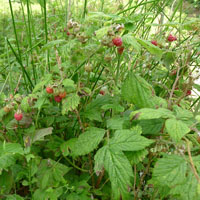
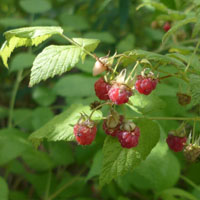
Rubus laciniatus . . . . . Cut-leaved Bramble
In introduced plant that can become invasive

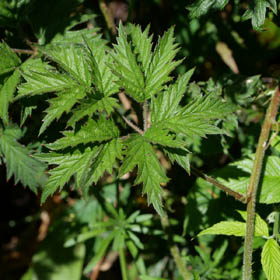
Rubus phoenicolasius . . . . . . Japanese wineberry
Planted and infrequently naturalised

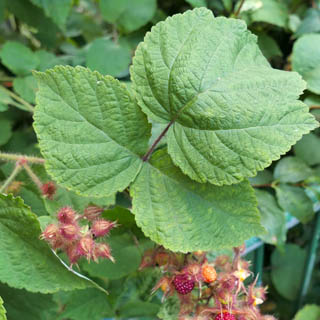
Rubus saxatilis . . . . . . Stone bramble
Rather scattered esp. on basic mountain slopes

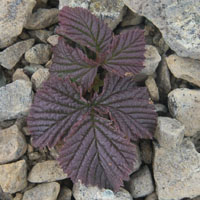
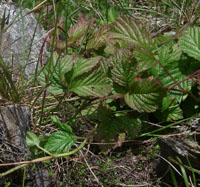
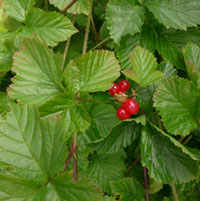
Rubus spectabilis . . . . . . Salmonberry
Naturalised esp. in the NW and islands where it can be a serious invasive sp.
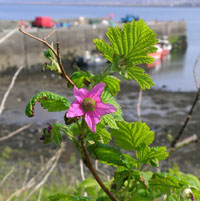
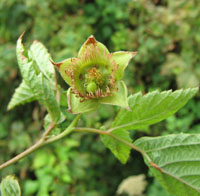
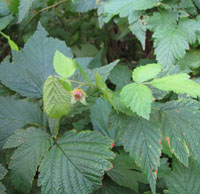
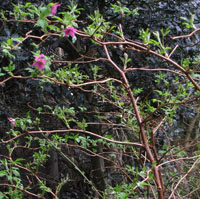
Rubus tricolor . . . . . . Creeping chinese bramble
Grown as ground cover but spreading

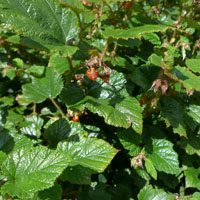
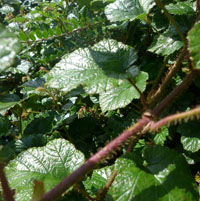
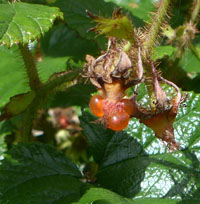
Burnets (Sanguisorba and Poterium)
Choose from the below:
Poterium sanguisorba
Poterium sanguisorba
Sanguisorba officinalis
Sanguisorba officinalis


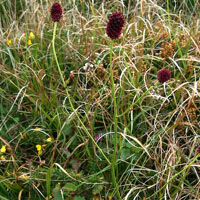
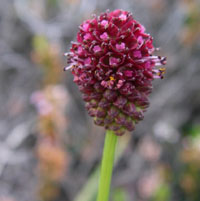
Salad burnet
Salad burnet
Greater burnet
Greater burnet
Sanguisorba . . . . . Burnet
Sanguisorba officinalis . . . . . Greater burnet
Locally frequent - esp. in C Br


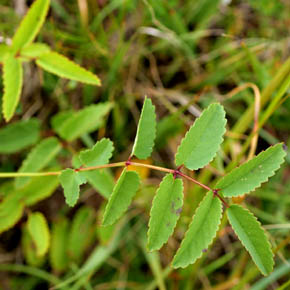
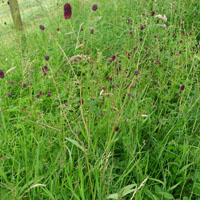
See also Poterium . . . . . Salad burnet

Sibbaldia
Sibbaldia procumbens . . . . Sibbaldia
Local on grassy/rocky mountains above c500m in Sc

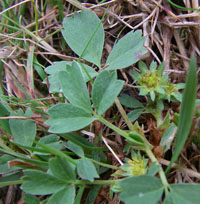
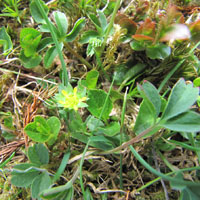
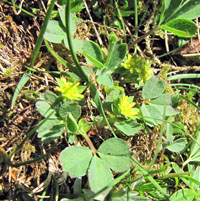
Sorbus - Rowan and whitebeams
Many species and apomictic variants, or microspecies, have been recognised, only some of the best-known ones are shown here. In addition the 'species' mentioned below include some that are thought to be intergeneric crosses, and thus should probably be given different generic names as indicated below
Whitebeam
Rowan
Wild Service tree
Sorbus aria agg. . . . . Common Whitebeam
An apomictic sp. for which many variants have been idd, native in the S but widely planted (see below for other examples)
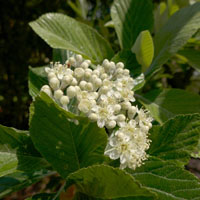
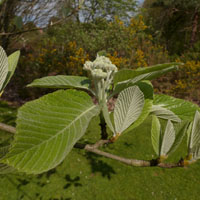
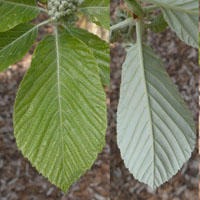
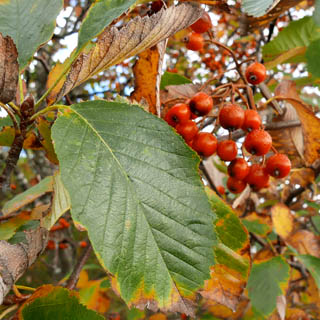
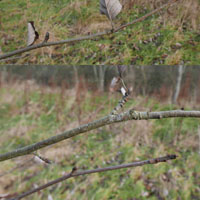
Sorbus aucuparia . . . . Rowan
Throughout Br and Ire, extends to high altitudes on mountains
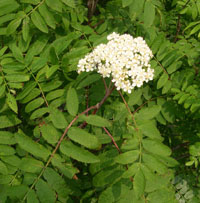
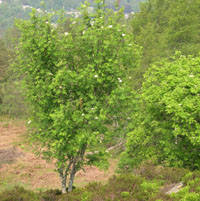
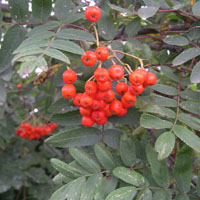
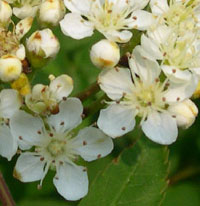
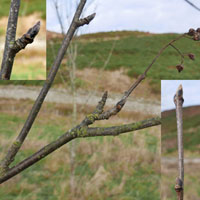
Sorbus torminalis . . . . Wild service tree, Checker tree
Local in woods on clay or limestone in S & C Br, N to Westmoreland
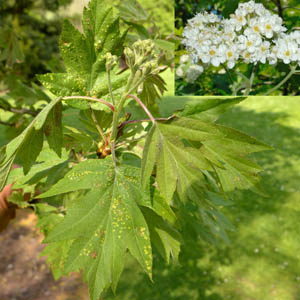
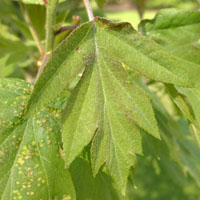
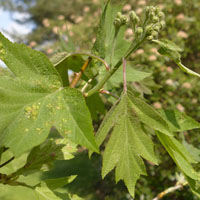
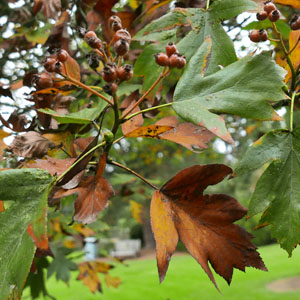
A number of other Sorbus "spp." are shown below (most very rare in the wild):
Note that some of these, notably Sorbus pseudofennica and Sorbus arranensis are thought to be intergeneric crosses and possibly properly named Hedlundia pseudofennica and Hedlundia arranensis
S. pseudofennica
S. rupicola
S. arranensis
S. lancastrensis
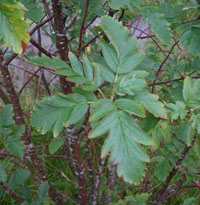
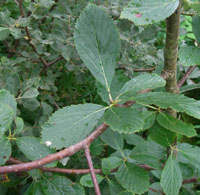
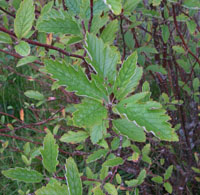
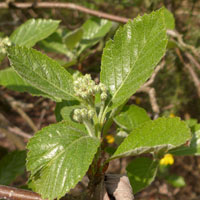
Arran service tree
Rock whitebeam
Arran whitebeam
Lancastrian whitebeam
S. intermedia
S. devoniensis
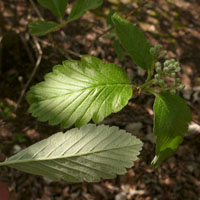
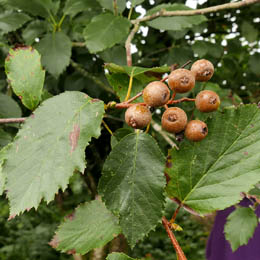
Swedish whitebeam
Devon whitebeam
Spiraea . . . . . Brideworts
Many varieties/spp. have been naturalised as garden escapes; some of the more common are illustrated
Spiraea alba . . . . Bridewort
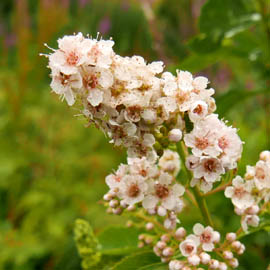
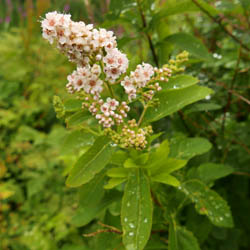
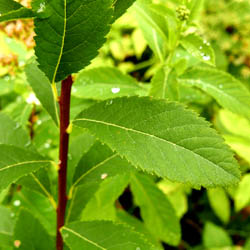
Spiraea japonica . . . . Japanese Spiraea
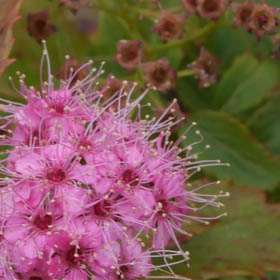

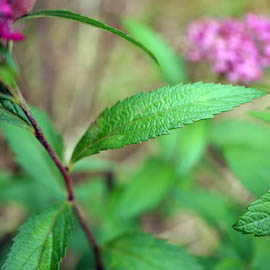
Spiraea x arguta . . . . Bridal spray
Much planted and occurs scattered in Br
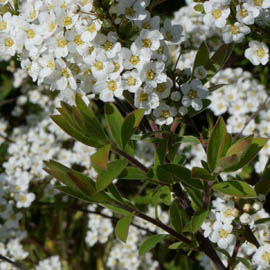
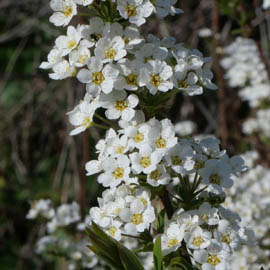
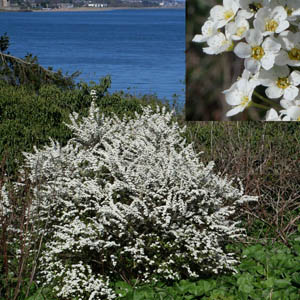
Spiraea x pseudosalicifolia . . . . Confused bridewort
The most common variety

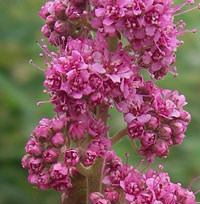
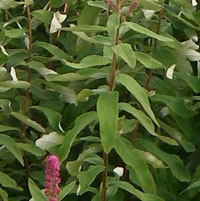
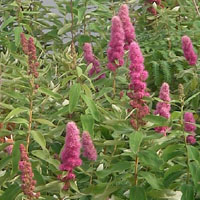
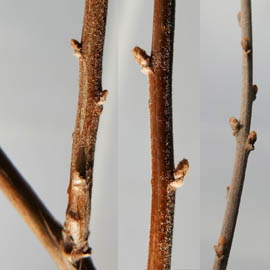










 Poterium
Poterium 































































































































































































































































































































